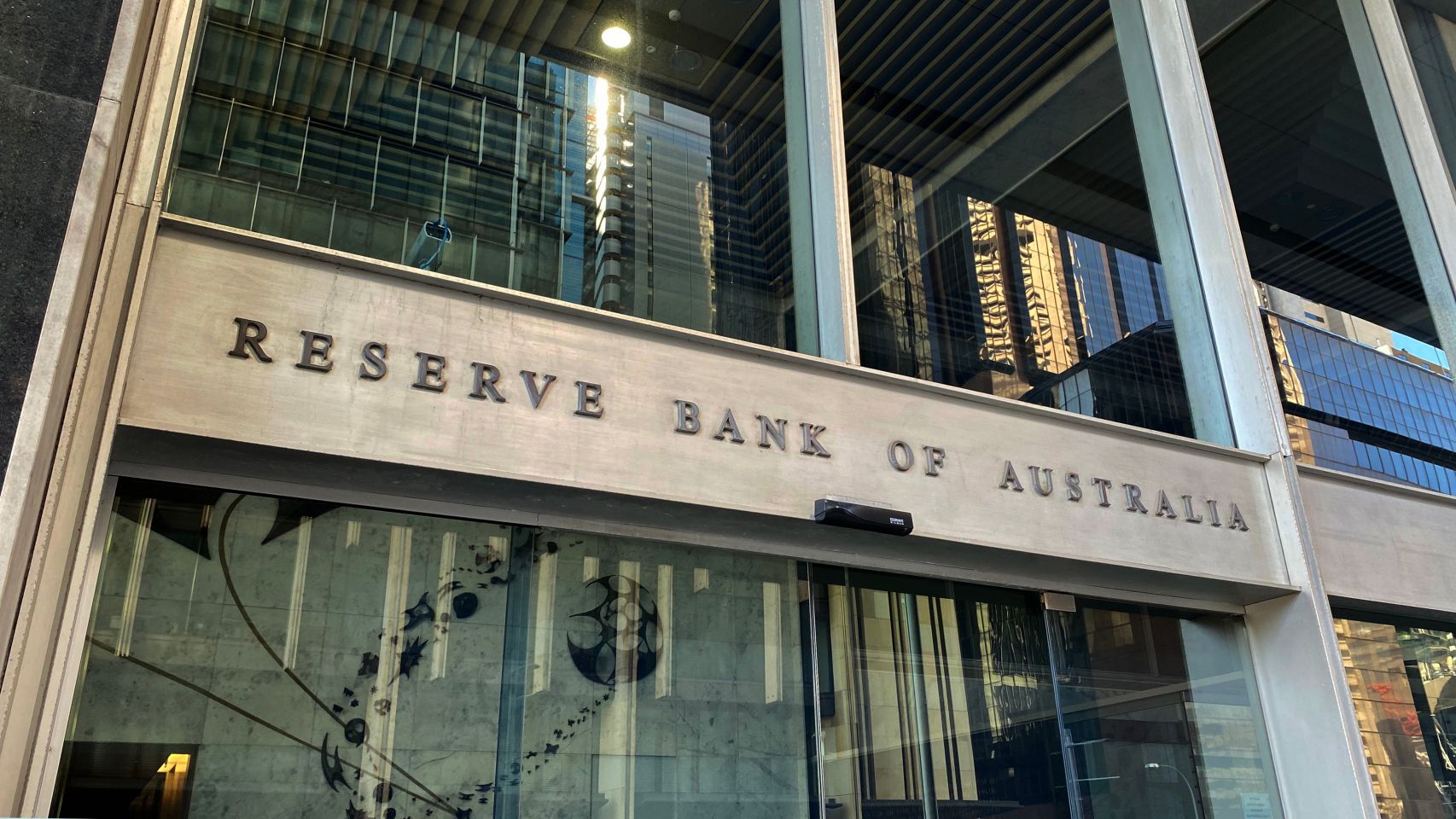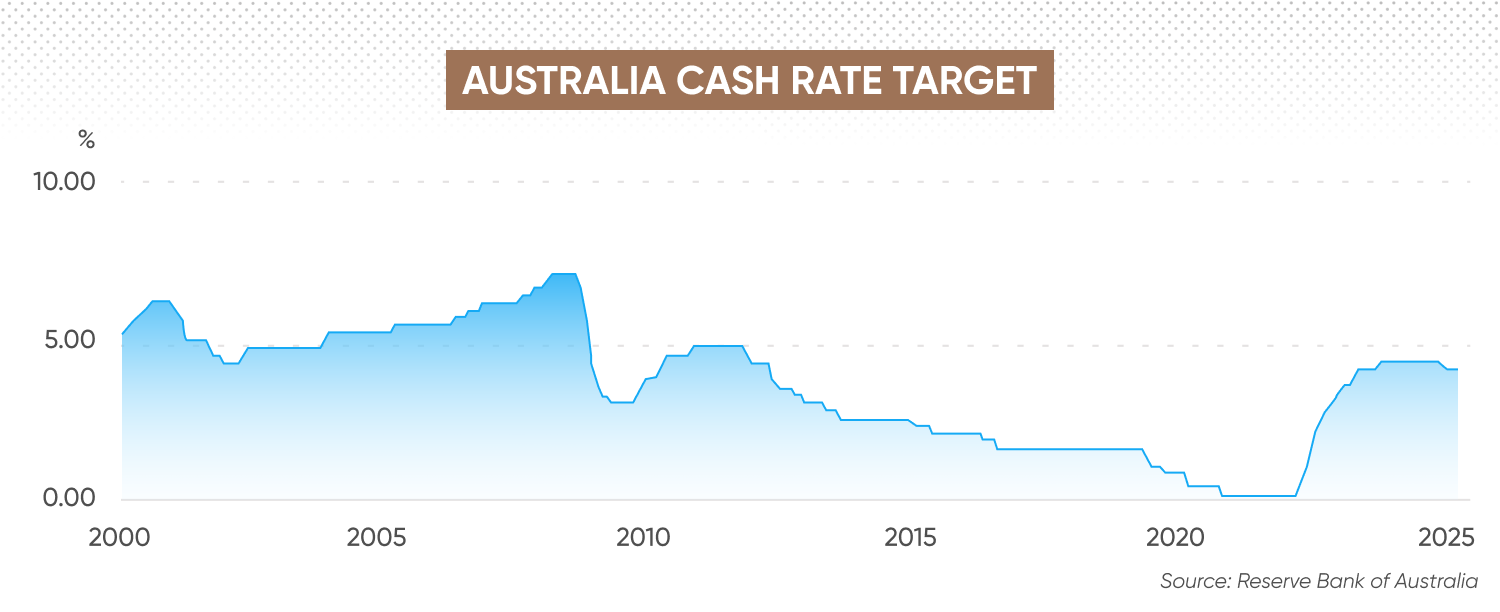Australian interest-rate projections: where will rates be in 5 years?
As one of the most closely watched economic indicators, Australian interest-rate projections offer valuable insight into the future of the country’s economy.
The Reserve Bank of Australia (RBA) sets the official cash rate, which influences everything from mortgage repayments to business lending and the strength of the Australian dollar.
For investors, traders, and businesses, understanding the RBA’s likely path over the next five years is essential. These projections help inform financial planning, risk management strategies, and market positioning.
How the RBA sets interest rates
The RBA is Australia’s central bank and is tasked with maintaining economic stability and full employment. Its primary tool is the official cash rate – the interest rate on overnight loans between banks. This rate then influences the broader economy.
Interest rate decisions are driven primarily by inflation, with the RBA aiming to keep inflation within its 2-3% target band. If inflation rises above this range, the RBA may increase rates to cool the economy. If inflation is low or the economy is sluggish, it may lower rates to stimulate growth.
Key indicators the RBA monitors include:
- Consumer price index (CPI) inflation
- GDP growth
- Employment and wage trends
- Global economic conditions
In 2022 and 2023, the RBA embarked on an aggressive tightening cycle to combat surging inflation, raising rates from record lows in response to post-pandemic price pressures and supply chain issues.
Australia’s current interest-rate environment
As of April 2025, the RBA’s cash rate stands at 4.1%, having held steady for several months following a period of sharp increases. Inflation has eased considerably from its 2022 peak of over 7%, with data showing annual CPI inflation around 3.2%.
The Australian economy has shown signs of resilience, though growth has moderated. GDP expanded by just 1.4% year-on-year in Q4 2024, while wage growth and the labour market remain tight. The RBA has adopted a wait-and-see approach, indicating that further moves will depend on incoming data.

Key factors influencing interest-rate projections in Australia
Several domestic and international forces will shape the interest-rate forecast in Australia, as well as interest rate predictions in Australia over the next five years:
- Inflation trajectory: inflation is expected to gradually return to the RBA’s target band, though services inflation and housing costs remain sticky.
- Wage growth: sustained increases in wages could fuel inflation and force the RBA to maintain higher rates.
- Labour market strength: unemployment remains low at around 4.1%, but any rise could shift the policy stance toward easing.
- Global interest rates: the actions of the US Federal Reserve, European Central Bank, and Bank of England may influence Australian monetary policy via capital flows and currency effects.
- China and commodity prices: as a major trading partner, China’s economic health and demand for Australian exports, especially iron ore and coal, are significant drivers.
Create an account Open a demo account
Forecasts for Australian interest rates (2025-2030)
With inflation easing and the economy showing signs of cooling, attention has turned to what the RBA might do next. Australian interest-rate forecasts help paint a picture of the likely trajectory for borrowing costs over the coming years. While no prediction is guaranteed, examining expert projections for the short and medium term can help consumers, businesses, and investors prepare for what's ahead.
Compare projected US interest rates to see how transatlantic policy divergence might impact global markets.
Short-term projections (2025-2026)
Most economists anticipate that the RBA will begin cutting interest rates in late 2025 or early 2026, assuming inflation continues to decline and growth remains subdued.
- Westpac anticipates the RBA cash rate could decrease to 3.35% by the end of 2025.
- NAB expects the cash rate to reach 3.1% in early 2026 after a series of cuts.
- ANZ Research sees the RBA holding steady through 2025, with a potential rate cut in August that year, depending on inflation data.
Medium-term projections (2027-2030)
Projected interest rates in 5 years in Australia are more difficult to come by, but some believe that rates may see a return to a more neutral setting over this time period.
- AUDtoday.com suggests that the RBA cash rate could be around 3.60% in February 2027, with potential fluctuations within a range of 3.35% to 3.85%.
- IMF commentary has suggested the RBA's cash rate may average 3.5% in 2027 and 3.1% in 2028.
- Property Update: an analysis suggests that if Australia avoids a recession, interest rates could trend back to pre-pandemic levels of around 2.5% to 3% during 2027-2028.
Much will depend on inflation persistence, global financial conditions, and domestic structural trends in housing, productivity, and employment. As always, it's important to approach such long-term projections with caution, as they are subject to considerable uncertainty and may not account for unforeseen economic developments.
What RBA interest-rate forecasts mean
RBA interest-rate forecasts shape everyday financial decisions for households, businesses, and investors. Whether people are planning a home loan, managing company cash flow, or trading AUD currency pairs, projected RBA rates offer vital clues about what to expect in the months and years ahead. Understanding how different sectors respond to rate changes can help make more informed decisions in a shifting economic environment.
For households
- Mortgage rates: with the cash rate projected to ease modestly, homeowners may see slight relief on variable-rate mortgages.
- Savings accounts: Interest paid on deposits may fall, encouraging spending or investment.
- Consumer loans: Borrowing costs may decline, but not to the ultra-low levels seen in the 2010s.
For businesses
- Credit access: lower interest rates could make business loans more affordable, supporting investment and hiring.
- Operating costs: lower financing costs may boost profit margins, particularly in rate-sensitive sectors.
- Confidence: stable or falling rates can improve business sentiment and long-term planning.
For traders and investors
- Equities: easing rates may support equity markets, particularly in sectors like real estate, financials, and consumer goods. Learn how to trade stocks if you’re new to equities.
- Bonds: long-term bonds could benefit from falling yields, but returns may be muted compared to high-rate environments.
- Forex: the AUD may weaken if the RBA cuts more aggressively than global peers, impacting currency pairs like AUD/USD and AUD/JPY.
Read our guide to forex trading to help you understand how rate shifts impact FX pairs, and our guide to indices trading for more on navigating key index movements.
Conclusion: The path ahead for Australian interest rates
Australian interest rate projections over the next five years point to a moderate easing cycle, followed by a return to neutral settings. While the RBA is unlikely to return to emergency-level lows, it is expected to gradually unwind some of the tightening seen in 2022-2024.
Short-term forecasts suggest modest cuts in 2025 or 2026, bringing the cash rate closer to 3%. Medium-term expectations suggest stabilisation between 2.75% and 3.25%, barring any significant economic surprises.
For consumers, businesses, and traders, these projections can help inform key financial decisions – from mortgages and loans to investment portfolios and forex strategies.
Stay up to date with the latest market trends and explore our full range of CFD markets.
FAQs
What is the interest rate in Australia?
As of April 2025, the official cash rate set by the Reserve Bank of Australia (RBA) is 4.10%.
Who controls interest rates in Australia?
The RBA (Reserve Bank of Australia) is responsible for setting the official cash rate based on inflation, employment, and economic conditions.
How often are interest rates adjusted?
The Reserve Bank Board of the RBA meets 11 times a year on the first Tuesday of each month, with the exception of January. In each meeting, the board decides whether to raise, cut or keep the cash rate, depending on the macroeconomic indicators at the time of the meeting.
Will interest rates go up?
Most forecasts suggest that interest rates in Australia have peaked and may begin to decline gradually in 2025 or 2026. However, future moves will depend on inflation and economic data.
How often are interest rates adjusted in Australia?
The RBA reviews interest rates 11 times per year, usually on the first Tuesday of each month (except January). Changes are announced after each monetary policy meeting.